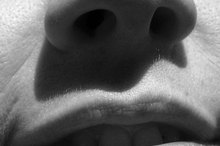Your nose is comprised of bone and cartilage, separated into two symmetrical hollow nostrils. Open sinus spaces sit in your forehead, at the top of your nostrils. As part of the respiratory system, the nose serves several functions.
If you are experiencing serious medical symptoms, seek emergency treatment immediately.
Breathing
Air flows in and out during normal breathing. The inner lining of the nose has many blood vessels at the surface. Blood flowing through your nose warms the air as your breathe in 2. Your nose also humidifies the air before it gets to your lungs.
- Air flows in and out during normal breathing.
- Blood flowing through your nose warms the air as your breathe in 2.
Cleansing
Phantom Odors & Brain Cancer
Learn More
The nose has many small hairs inside the nostrils. These hairs act as a filter, removing dirt and particles before the air enters the lungs. Sneezing and nose blowing also help remove the particles out of your body.
Smell
Smell is one of the most important functions of the nose. The sense of smell is not completely understood. Smell is a key component of memory, physical attraction and emotional connections. The olfactory nerves are cranial nerves that allow communication between your nose and brain. Conditions, such as a cold, will decrease your sense of smell. Some people suffer from a condition called anosmia, which is the inability to smell.
- Smell is one of the most important functions of the nose.
- The olfactory nerves are cranial nerves that allow communication between your nose and brain.
Taste
Phantom Odors & Brain Cancer
Learn More
Although taste is a completely separate sense than smell, the nose plays a role in the way the tongue perceives taste. The aroma of the food plays a role in the taste. Individuals with a congested nose report a decreased sense of taste.
Voice
Air resonating in your nose affects the sound of your voice 2. The shape of your septum also plays a role in the sound of your voice. As a result, surgery on your nose may also alter the sound of your voice.
Related Articles
References
- Alexandria University: Department of Otorhinolaryngology -- Anatomy of the Nose
- The Merck Manual: Nose and sinuses
- Sforza C, Grandi G, De Menezes M, Tartaglia G, Ferrario V. Age- and sex-related changes in the normal human external nose. Forensic Sci Int. 2011;204(1-3):205.e1-205.e9. doi:10.1016/j.forsciint.2010.07.027
- Sharma P, Arora A, Valiathan A. Age changes of jaws and soft tissue profile. ScientificWorldJournal. 2014;2014:301501. doi: 10.1155/2014/301501
- Lee JW, McHugh J, Kim JC, Baker SR, Moyer JS. Age-Related Histologic Changes in Human Nasal Cartilage. JAMA Facial Plast Surg. 2013;15(4):256-262. doi:10.1001/jamafacial.2013.825
- Feng Wen Y, Ming Wong H, McGrath CP. A longitudinal study of facial growth of Southern Chinese in Hong Kong: Comprehensive photogrammetric analyses. PLoS One. 2017; 12(10): e0186598. doi: 10.1371/journal.pone.0186598
- Sforza, Chiarella, Grandi, Gaia, De Menezes, Marcio, Tartaglia, Gianluca M and Ferrario, Virgilio F. Age- and Sex-Related Changes in the Normal Human External Nose. Forensic Science International. Vol 204, Issue 1-3, pp. 205.e1-205.e9
- van der Heijden P, Korsten-Meijer AG, van der Laan BF, Wit HP, Goorhuis-Brouwer SM. Nasal growth and maturation age in adolescents: a systematic review. Arch Otolaryngol Head Neck Surg. 2008 Dec;134(12):1288-93. doi: 10.1001/archoto.2008.501
Writer Bio
Abigail Adams began her freelance writing career in 2009, teaching others about medical conditions and promoting wellness by writing on online health and fitness publications. She is educated and licensed as a registered nurse, having received her degree from North Georgia College and State University.








